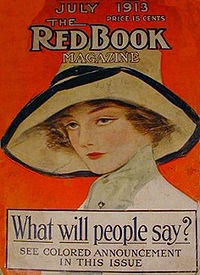I ran across a curious piece on the genesis of the popular magazines we see in the racks near the checkout line in supermarkets. My daughter had asked me the meaning of the phrase "pulp fiction", so I began an online search for examples of publications that printed commercial tales to modern readers. From this, I learned about the role that pulp played in the rise of the glossy.
Women's magazines started out as places for many authors to have their stories published to a wider audience; stories that were not yet considered literature and perhaps even trashy by the starched and corseted standard-bearers of good taste. But some of the starched and corseted were also reading these magazines for the fantasies they inspired.
 |
| The RedBook Magazine, July 1913 |
One such magazine was called The Red Book Illustrated, first published in 1903. Over the next several years it featured stories by both men and women such as Jack London, Edith Wharton, Edgar Rice Burroughs, Agatha Christie and F. Scott Fitzgerald. Photos and illustrations of actors and actresses and other notable personalities helped to make the magazine a quick success with a wide readership.
Soon two more publications were introduced, The Blue Book and The Green Book. The Blue Book carried a supplement called "Stageland" on various actors of the theater. The covers of these books also showcased early graphic art and illustrations by aspiring artists. The Blue Book ran for 45 years, titled Blue Book of Fiction and Adventure, Bluebook for Men, and was finally shortened, like Redbook, to Bluebook, until its last issue in 1975.
 |
| The Blue Book Magazine, "Stageland" supplemental, August 1911 |
In 1932, Redbook's publisher broke into producing serial stories on radio, called Redbook Magazine Radio Dramas, with a host who selected the stories. As television began to attract people to viewing stories, over reading or listening to them, magazines changed both their focus and demographic. They began to include nonfiction articles on issues of the day, such as racial prejudice, nuclear weapons, and McCarthyism. By the 1960s, Redbook focused on a female readership and highlighted Dr. Benjamin Spock and Margaret Mead on the topics of childrearing and women's rights, along with its core of fiction. Around this time it began to win National Magazine awards.
By the 1970s, Redbook changed hands and became a member of what was called "The Seven Sisters" of magazines, named after the constellation Pleiades, which included Good Housekeeping, Better Homes and Gardens, Family Circle, Woman's Day, Ladies' Home Journal and McCall's.
Each magazine had a different inception and history. Family Circle and Woman's Day were both circulars for grocery stores, Good Housekeeping was aimed at homemakers, Lady's Home Journal was general interest, and Better Homes and Gardens introduced home design for the affluent. McCall's was similar to Redbook in its format of quality fiction, written by Ray Bradbury, Willa Cather, John Steinbeck, Anne Tyler and Kurt Vonnegut.
 |
| McCall's Fashion 1916 |
McCall's was also a means of advertising the fashion designs and sewing patterns of its owner, James McCall, a Scottish immigrant. In the 'Thirties, McCall's was divided into three sections: News and Fiction, Homemaking, Style and Beauty. Starting in the 'Fifties, it included a regular character of a little girl named Betsy McCall, a paper doll accompanied by pages of cut-out fashionable clothing. Also keeping up with the demand for fiction at the time, McCall's was the first women's magazine to print a complete novel in one issue.
Redbook again changed its focus in the 1990s to appeal to a large audience of young women who were less interested in fiction and more interested in articles about balancing home and work life. The featured stories were accounts of married women dealing with modern problems who sought to overcome them and achieve intellectual, personal and political growth with an emphasis on humanitarian causes.
This format carried over into other magazines currently owned by the Hearst Corporation such as Harper's Bazaar, Elle, and O, the Oprah Magazine. Whether the readers subscribe to pulpy serials full of fantastical creatures, or spend hours fantasizing about the lifestyles of celebrities, women's magazines have had a solid footing in the descent of the author and in the current of mainstream thoughts and practices.
No comments:
Post a Comment